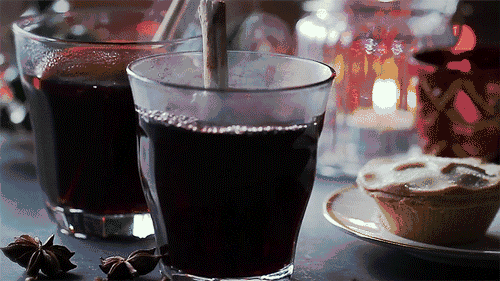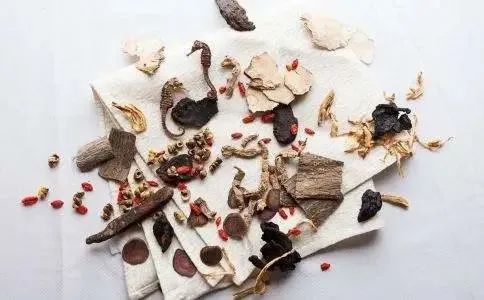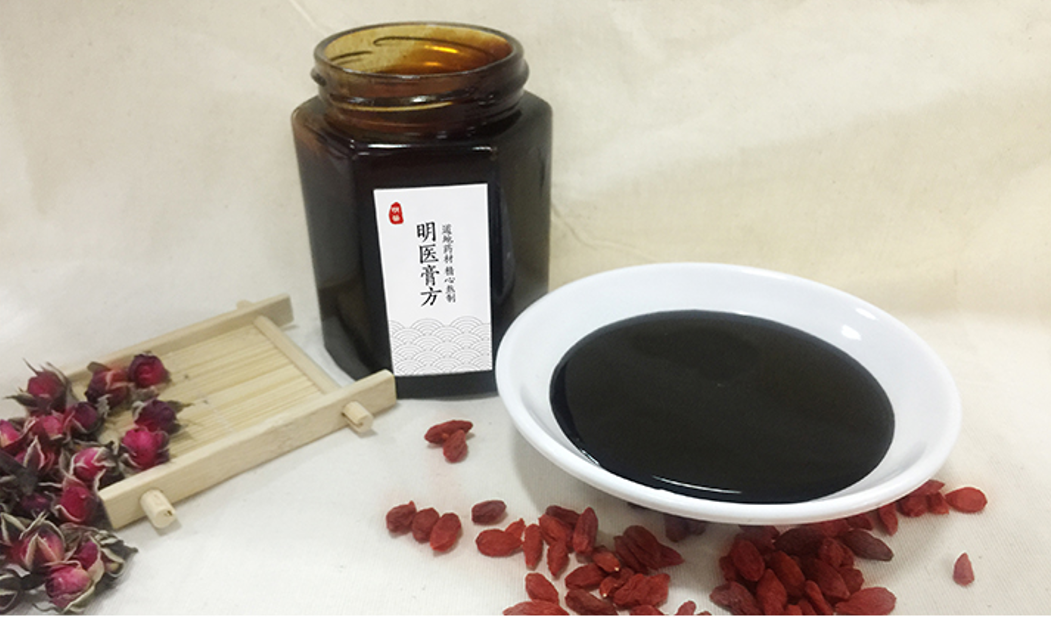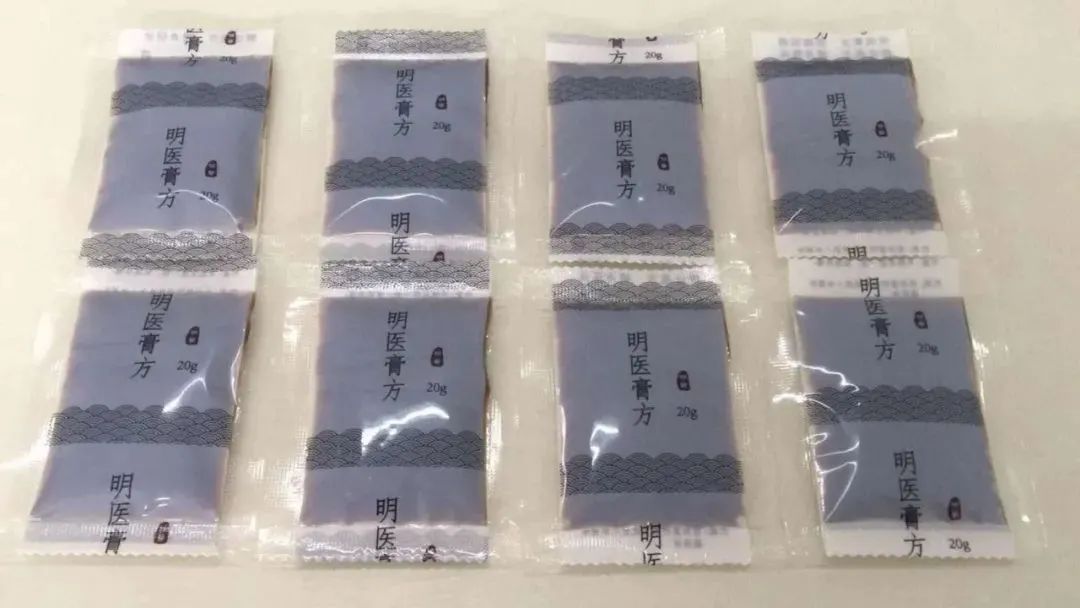
This year’s cold weather has arrived earlier than in previous years. The Double Ninth Festival has passed, and the beginning of winter is not far off; winter is gradually approaching. This is the perfect time to nourish the body.

How to nourish the body? There are many methods, but the correct approaches are few. Nourishing health or treating illness requires personalized customization based on syndrome differentiation.
To meet these conditions, the most convenient, delicious, and reliable method is the medicinal paste.
Medicinal paste, also known as gao (膏), is one of the 27 commonly used forms in clinical practice, and is also one of the five major forms: decoction, pill, powder, paste, and elixir. It has a long history, with relevant records in the “Huangdi Neijing” (黄帝内经).
It is a preparation made by traditional Chinese medicine (TCM) practitioners based on each individual’s constitution and symptoms, prescribing Chinese herbal formulas. The herbal pieces are decocted multiple times, the juice is filtered to remove the dregs, heated and concentrated, and then mixed with rock candy, honey, or maltose, resulting in a relatively viscous semi-fluid preparation that can treat diseases, replenish deficiencies, and regulate the body.

01
Case Sharing of Medicinal Paste Treatment
01
Menstrual Regulation Case
Ma, female, 32 years old
Medical History: Menstrual cycle is regular, but experiences lower abdominal heaviness and cold pain with blood clots, menstruation lasts 5-7 days, with increased discharge before and after menstruation, color white and thick, easily wakes at night, has not conceived after many years of marriage, tongue coating is thin, pulse is weak.
Syndrome Differentiation: Liver Qi stagnation, blood stasis obstructing the interior, kidney essence deficiency, unsettled heart spirit, mixed deficiency and excess.
Treatment Plan: Soothe the liver and regulate Qi, invigorate blood and eliminate stasis, tonify kidney essence, and improve mood.
Formula: 300g of raw and cooked Rehmannia (生熟地), 200g of Angelica sinensis (当归), 200g of fried white and red Peony (炒赤白芍), 200g of Salvia miltiorrhiza (紫丹参), 150g of vinegar-treated Bupleurum (醋柴胡), 100g each of green Chenpi (青陈皮), 200g of processed Cyperus (制香附), 200g of Atractylodes (炒白术), 200g of Poria (茯苓), 200g of powdered Moutan (粉丹皮), 200g of Chinese Wolfberry (山萸肉), 200g of Chinese Yam (淮山药), 200g of Su (苏梗), 200g of fried Corydalis (炒延胡索), 150g of raw Cat-tail pollen (生蒲黄), 150g of Wulingzhi (五灵脂), 120g of Curcuma (广郁金), 200g of Eucommia (杜仲), 200g of Dipsacus (川断), 100g of Cinnamon (肉桂, added later), 80g of dried Ginger (干姜), 80g of Fennel (小茴香), 120g of Myrrh (没药), 120g of Chuanxiong (川芎), 300g of raw Coix (生苡仁), 400g of cooked Jujube seeds (熟枣仁), 250g of Polygala (夜交藤), 250g of Albizia bark (合欢皮), and 120g of prepared Polygala (炙远志).
Method of Use: Soak the above herbs in water for 10 hours, decoct three times, filter out the dregs, add 300g of donkey-hide gelatin (阿胶), 300g of tortoise shell gelatin (鳖甲胶), and 800g of rock candy, and concentrate to form a paste. Take one tablespoon each morning and evening, dissolve in warm water, and take on an empty stomach. Discontinue if experiencing cold or fever.

This medical case is excerpted from the “China Traditional Chinese Medicine News”.
02
Case of Elderly Patient
Zhang, male, 80 years old.
Medical History: Fatigue and weakness, left foot numbness and soreness, muscle pain, dry mouth at night, phlegm is sticky and difficult to expel. Pulse is wiry and slippery, tongue coating is yellow and greasy.
Syndrome Differentiation: Age-related decline, liver and kidney deficiency, excess liver Yang, internal phlegm-heat, wind-phlegm obstructing the channels.
Treatment Method: As it is early winter, prevention of falls is crucial. Use paste instead of decoction for gradual effect.
Formula:90g of Astragalus membranaceus (别直参须), 60g of Polygonatum (千年健), 60g of Chaenomeles (宣木瓜), 60g of Fritillaria (川贝母), 90g of Poria (茯苓神), 150g of raw Oyster (生牡蛎), 90g of Ophiopogon (大麦冬), 60g of Achyranthes (淮牛膝), 90g of clam powder (海蛤粉), 90g each of South and North Glehnia (南北沙参), 60g of prepared Euphorbia (制豨莶), 90g of soybean pod (料豆衣), 90g of Tribulus (潼白蒺藜), 30g of tangerine peel (橘络), 60g of Dendrobium (肥玉竹), and 90g of cooked Rehmannia (大熟地), 90g of Mulberry branches (桑枝), and 150g of Salvia miltiorrhiza (紫丹参).
Method of Use: Decoct the above ingredients to obtain a concentrated juice, simmer until thick, and add 500g of white rock candy to form a paste. Take one spoonful each morning with boiling water.
Remarks:
In elderly patients, liver and kidney have declined, Yin and Yang are imbalanced, and the meridians are obstructed, making them susceptible to wind-phlegm invasion, presenting a mixed deficiency and excess pattern. In winter, the paste nourishes the liver and kidney, strengthens the foundation, dispels wind and transforms phlegm, and regulates the liver and opens the channels. The formula uses Astragalus to greatly tonify the vital energy, while cooked Rehmannia, Dendrobium, Glehnia, and Ophiopogon nourish Yin fluids to seek balance of Yin and Yang; combined with Fritillaria, clam shell, and other phlegm-transforming herbs, along with Polygonatum, Chaenomeles, and Mulberry branches to open the channels and eliminate phlegm; additionally, Salvia miltiorrhiza is included to remove blood stasis from the meridians, promoting blood circulation and preventing stroke. The entire formula addresses both the root and branch, aiming to prevent stroke gradually.

This medical case is excerpted from Teacher Yan Yilu’s “Practical Medicinal Paste” published by Shanghai Science Popularization Press.
Although medicinal pastes are beneficial, the price of a single paste often exceeds a thousand, which can be daunting. What determines the price of a medicinal paste?
First, Quality of Herbs
First, the preparation of medicinal pastes requires careful selection of Chinese medicinal materials. The price and efficacy of the same type of herbs vary based on origin, harvest season, etc.
Only high-quality herbs can justify the ancient craftsmanship, and the resulting paste can be considered a precious product.
Expensive herbs are an important component that reflects the efficacy of replenishing deficiencies. The sources of fine herbs mainly include: ginseng, precious animal medicines, and valuable plant medicines.
Since these are precious herbs, the price is naturally high. If one seeks alternative herbs, it may lead to a significant reduction in efficacy.
Animal gelatin is an important matrix and excipient for making medicinal pastes, commonly using donkey-hide gelatin, tortoise shell gelatin, and deer antler gelatin, which are also quite expensive.
Moreover, to ensure the effectiveness of the paste, the total amount of gelatin in a single medicinal paste usually ranges from 200 to 500 grams.

Second, Large Formulas
The number of herbs in a medicinal paste formula typically ranges from 30 to 40, and due to the long duration of use, the amount of herbs used is often larger. The large number of herbs in a medicinal paste is key to its significant efficacy.
Mr. Qin Buwei once said:
With ginseng, donkey-hide gelatin, etc., their nourishing effects are limited to specific areas. For example, ginseng nourishes Qi, donkey-hide gelatin nourishes blood, but a medicinal paste, which combines multiple herbs, addresses various aspects comprehensively.

Third, Complex Craftsmanship
Medicinal pastes cannot be made without intricate preparation techniques.
Adhering to the principle of “one person, one formula, one pot,” they are made using traditional manual methods. Specially selected ancient copper pots are used for preparation, and aged bamboo is employed as the tool for making the paste, ensuring the original flavor and superior quality of the medicinal paste.
The preparation of a single medicinal paste involves eight processes: examination, formulation, soaking, decocting, filtering, settling, stirring, and concentrating. Each step undergoes complex procedures to produce a high-quality paste that can form a flag and drip into beads.
Suitable Population
(1) Sub-healthy Individuals: Mainly characterized by long-term fatigue, recurrent colds, anxiety, insomnia, dark circles, dizziness, palpitations, tinnitus, decreased vision, reduced libido, vaginal dryness, lack of appetite, hair loss, and graying.
(2) Chronic Disease Patients and Post-chemotherapy Patients: Using medicinal pastes for treatment can promote recovery, replenish deficiencies, dispel depression, delay or inhibit tumor recurrence, and improve quality of life and survival rates.
(3) Female Population: Women often exhibit symptoms of Qi and blood deficiency, liver and kidney deficiency, and Yin-Yang imbalance due to their physiological characteristics related to menstruation and childbirth, such as dizziness, fatigue, lower back and knee soreness, insomnia with vivid dreams, melasma, irregular menstruation, postpartum deficiency, and menopausal syndrome.
(4) Children with Anorexia, Accumulated Food, and Poor Spleen and Stomach: can take medicinal pastes made from formulas like Si Jun Zi Tang (四君子汤) or Ping Wei San (平胃散) to strengthen the spleen.
(5) Preventive Health Seekers: Medicinal pastes can strengthen the body and dispel pathogens, enhancing immune function to achieve disease prevention, especially for preventing influenza, thus serving the purpose of preemptive health care.
02
Production Process of Medicinal Paste
The production of medicinal paste includes formulation, registration, soaking, decocting, concentrating, collecting the paste, quality inspection, and packaging.
Formulation: Strictly follow the prescription provided by the physician, ensuring one formula per person without confusion. After formulation, weigh, verify, and sign. Generally, the weight of herbs in a medicinal paste should be over 3kg; too little will not yield a paste.
Registration: Register the production ledger for reference. Information includes: start and end time of production, patient name, weight of herbs, types and amounts of auxiliary materials added, yield of paste (number of bags), producer, special requirements, etc.
Soaking: Soaking the herbs is a crucial step in the processing of medicinal paste, as it significantly affects the outcome. The core is to ensure that the herbal pieces are fully soaked, allowing the effective components to dissolve quickly during decoction. First, check for any special requirements for certain herbs, such as those that need to be decocted first or separately; then, place the herbal pieces in a clean stainless steel container, fully submerged in 6-8 times the amount of clean water; finally, the soaking liquid is used for the first decoction, with a soaking time of no less than 4 hours.
Decoction: Add the soaked herbs and soaking liquid into the decoction machine to begin decocting. Choose a closed mode (120°C, pressure 0.085MPa), and decoct for 60 minutes for the first decoction. After decoction, filter through a 40-mesh sieve, then add 6 times the amount of water for the second decoction, using the same method as before. After decoction, filter the liquid again. Discard the dregs and mix the liquid from the first and second decoctions.
Concentration: Pour the filtered herbal liquid into a concentrator, seal it well. Run the cooling water pump and vacuum pump to create a negative pressure vacuum state (vacuum gauge at negative pressure 0.08mpa), while running the heating plate and heating belt to concentrate. Stop concentrating when the remaining herbal liquid is about 4000ml.
Collecting the Paste: After concentrating, filter the herbal liquid and pour it into a copper pot, turn on the induction cooker, and simmer on low heat. Add pre-treated herbal gel or auxiliary materials (mainly rock candy, honey, or maltose) into the concentrated liquid, stirring continuously until the gel blocks are completely melted, while observing the concentration of the paste. When the concentrated liquid forms “fish-eye bubbles” and can stretch into a flag or drip into beads (the paste should form beads in water without dispersing), it is ready. (The paste will further thicken after cooling). The yield of the finished paste is generally around 50%, while the yield of clear paste is around 30%, depending on the herbs in the formula.


Special Attention to Handling Specific Herbs During Paste Collection:
(1) Separate Decoction: Herbs like American ginseng, red ginseng, saffron, etc., need to be soaked and decocted separately twice, extracting the juice, combining the decoction, filtering, and setting aside. When collecting the paste, directly mix into the concentrated herbal liquid.
(2) Ground and Mixed: Herbs like walnut kernels, which are both food and medicine, need to be cleaned, ground, and added directly into the paste during collection, stirring evenly until it becomes a paste.
(3) Powdered and Mixed: Herbs like ginseng, Sanqi, Cordyceps, amber, etc., that are not suitable for soaking and decocting, should be ground into fine powder and gradually sprinkled into the paste before it is nearly finished (or sifted in), or dissolved in an appropriate amount of boiling water to form a suspension and mixed into the paste.
Quality Inspection: The appearance of the paste should be fine in texture, with appropriate viscosity, no strange odors, and free from foreign objects like burnt residues or dregs.
Packaging: The completed paste should be filtered through 80-100 mesh, then moved to the packaging machine. Turn on the paste packaging machine, preheat the entire machine to ensure the sealing roller reaches the required temperature, and heat the media water in the glass container to 100 degrees Celsius to facilitate the dilution of the paste for automatic injection and packaging. After preheating, set the desired packaging amount of 10-50ML on the control panel, press the packaging button, and enter the automatic packaging program.
Storage: Since medicinal pastes are used over a long period, even in winter, care should be taken to prevent mold in warm winters. Generally, in winter, they can be stored in a cool place; in other seasons, they should be refrigerated. Bagged medicinal pastes are easy to store, carry, and accurately portioned, preventing mold. It is recommended that the packaging amount should not exceed a three-month supply to avoid spoilage due to prolonged storage.
03
Method of Administration
Generally, medicinal pastes are recommended to be taken on an empty stomach, as this allows the medicinal properties to be fully effective without interference from food.
A. Sublingual: Also known as “holding and dissolving.” Place the paste in the mouth and let it dissolve slowly to exert its medicinal effect.
B. Dissolving: Take an appropriate amount of paste, place it in a cup, pour in boiling water, stir to dissolve, and then take. If the formula contains many greasy or gelatinous herbs, the paste may be thick and difficult to dissolve, so it should be melted in boiling water before taking. Depending on the condition, warm yellow wine can also be used for dissolving.
C. Mixing: Grind gelatinous agents like donkey-hide gelatin or deer antler gelatin into fine powder, use appropriate soup or yellow wine, steam to heat, mix well, and take.
Dosage
① Generally, take one spoonful from the provided spoon (about 20g) each time.
② If it is a bagged medicinal paste, take one bag each time, also about 20g.


The spoon image is for reference; please refer to the actual item.
The dosage for elderly patients should be less than that for young adults; stronger individuals may take more than weaker patients; women’s dosage is generally less than men’s; during menstruation, pregnancy, and postpartum, women should take less than usual.
Storage Method
Since medicinal pastes are used over a long period, they should be stored in a cool place (like refrigeration). In warm winters, they should be steamed at high temperatures in water, and not directly heated on the stove to avoid pot cracking and burning. Care should be taken to prevent water from the pot lid from dripping onto the paste to avoid mold. When taking the paste daily, a fixed spoon should be used to prevent moisture from entering the pot and causing mold.
Precautions
① To achieve therapeutic effects, dietary restrictions should be observed during medication. For example, avoid eating radishes when taking ginseng paste, avoid pig and sheep blood and iron supplements when taking He Shou Wu paste; avoid drinking tea when taking nourishing pastes. Generally, during medication, avoid raw, cold, greasy, spicy, and hard-to-digest foods, as well as foods with special stimulating properties.
② Use a fixed spoon when taking, ensuring the spoon is dry before each use to prevent mold.
Types of Medicinal Paste Packaging
Our medicinal pastes are available in bagged and bottled forms. Bottles contain about 300g each, while bags contain 20g each, making them accurately portioned, easy to carry, and convenient for storage. You can choose according to personal preference. The production time for both bagged and bottled forms is about 5 days.
04
What are the differences between Chinese herbal decoctions and medicinal pastes?
1. Different Target Populations
Medicinal pastes have a mild effect, slow onset, and long duration, which TCM refers to as “gradual effect.”
Compared to herbal decoctions, they resemble a large biological system, interconnected, allowing potentially biased herbs to be milder and less harmful, making the efficacy of the herbs more aligned with individual constitution, providing a more comprehensive and in-depth approach to body regulation.
Acute patients often prioritize decoctions for treatment, while medicinal pastes have advantages in treating chronic diseases, replenishing deficiencies, and promoting health.
2. Different Taste
Decoctions require a larger volume of liquid, and the taste can be less than pleasant, with some being extremely bitter, making it difficult for many, especially children, to accept.
In contrast, medicinal pastes are sweet and moist, making them easier to take, as they include certain auxiliary materials like maltose during preparation, which enhances taste and has a tonifying effect on the spleen.
For patients needing long-term regulation and for children, they are a good choice, increasing medication compliance.
3. Different Craftsmanship
The process of making medicinal pastes is very complicated, usually requiring over a week for processing, thus incurring corresponding costs.
Decoctions are made by boiling herbal pieces in water, with some requiring pre-boiling, later additions, or bagging, and the boiling time varies based on efficacy.
Some powdered herbs need to be swallowed, requiring moderate temperatures during administration, which can be relatively cumbersome. If not choosing pre-decocted options, time must be spent on decocting.
Medicinal pastes, in addition to herbal pieces, can also include certain gels (like donkey-hide gelatin, tortoise shell gelatin, deer antler gelatin, etc.) and other tonifying agents, sugars, and auxiliary materials based on different syndromes.
Moreover, during processing, precious herbs are processed individually, using traditional methods of extraction and handling, resulting in higher drug concentration and easier absorption compared to tablets and pills.
Herbal decoction formulas are primarily composed of herbal pieces, requiring only the addition of water for decoction, generally without the need for additional auxiliary materials.
05
Why are medicinal paste formulas generally larger?
The number of herbs in a medicinal paste formula typically ranges from 30 to 40, or even more, making it relatively large.
Some may argue that medicinal pastes are merely for tonifying; for instance, ginseng nourishes Qi, and donkey-hide gelatin nourishes blood, so why not just take those two for Qi and blood nourishment instead of a large formula?
Mr. Qin Buwei explained that the large formulas are key to the significant efficacy of medicinal pastes. “With ginseng, donkey-hide gelatin, etc., their nourishing effects are limited to specific areas. For example, ginseng nourishes Qi, donkey-hide gelatin nourishes blood, but a medicinal paste, which combines multiple herbs, addresses various aspects comprehensively.”
Mr. Qin also cited several cases of severe patients who had lost blood and essence, where years of treatment by various doctors yielded no results, but after using medicinal pastes for a few months, their vitality gradually improved.
Of course, while the formulas are large, it does not mean that more is better; each herb is added based on the patient’s actual needs.
06
Warm Reminder
Medicinal pastes should be prescribed based on individual health conditions.
Copyright Notice:
1
Some images in the text are sourced from the internet; if there is any infringement, please contact for removal.
2
Follow “Mingyi” to learn more about TCM knowledge.

Mingyi Xiao Rui
If you have questions about medicinal pastes, please add
Long press the QR code to follow

